干旱气象 ›› 2025, Vol. 43 ›› Issue (3): 339-354.DOI: 10.11755/j.issn.1006-7639-2025-03-0339
北半球近70 a陆气耦合空间分布及其强度变化特征
- 甘肃省气候资源开发及防灾减灾重点实验室,兰州大学大气科学学院,甘肃 兰州 730000
-
收稿日期:2025-03-20修回日期:2025-05-18出版日期:2025-06-30发布日期:2025-07-12 -
作者简介:王澄海(1962—),男,教授, 主要从事青藏高原气候学、短期气候预测研究。E-mail:wch@lzu.edu.cn。 -
基金资助:国家自然科学基金项目(42175064)
Spatial distribution and intensity variation characteristics of land-atmosphere coupling in the Northern Hemisphere over the past 70 years
WANG Chenghai( ), SHANG Junxiang, ZHANG Feimin, YANG Kai
), SHANG Junxiang, ZHANG Feimin, YANG Kai
- Key Laboratory of Climate Resource Development and Disaster Prevention in Gansu Province, College of Atmospheric Sciences, Lanzhou University,Lanzhou 730000,China
-
Received:2025-03-20Revised:2025-05-18Online:2025-06-30Published:2025-07-12
摘要: 陆气耦合是地表与大气之间物质能量交换的重要一环,深入研究陆气耦合的时空变化特征,对认识陆气耦合在全球气候变化中的作用有重要意义。基于1950—2020年全球陆面数据同化系统(Global Land Data Assimilation System,GLDAS)土壤湿度、欧洲中期天气预报中心陆面再分析数据集(ERA5-Land)和全球降水气候中心(Global Precipitation Climatology Centre,GPCC)的降水数据,计算反映土壤水分对降水的反馈(λ)、潜热通量对土壤湿度的变化响应程度(ISM-LH)和降水对地表潜热通量变化响应程度(ILH-Pr)的3种陆气耦合指数,从不同角度分析北半球陆气耦合强度及其空间分布特征,确定北半球陆气耦合关键区。在此基础上,分析过去近70 a北半球陆气耦合的时空变化特征。结果表明,ISM-LH能较好地反映土壤湿度-蒸发耦合过程,对陆气耦合强度代表性最好。北半球有5个陆气耦合关键区,分别为北美耦合关键区(NA)、地中海耦合关键区(MS)、中亚-蒙古耦合关键区(CM)、非洲耦合关键区(AF)和南亚耦合关键区(SA)。夏季陆气耦合关键区的范围最广、耦合强度最强,春季次之。春夏之间的前后期耦合强度弱于春、夏季同期的耦合强度。1950—2020年陆气耦合关键区年耦合强度具有明显的线性变化趋势,NA、SA、AF关键区陆气耦合强度呈现减弱趋势,其中AF夏季减弱趋势最明显,气候倾向率为-3.61/10 a(p<0.01);MS和CM的陆气耦合强度呈现增强趋势,其中CM夏季的线性变化趋势最明显,气候倾向率为2.28/10 a(p<0.01)。在耦合关键区,陆气耦合强度和降水的线性变化趋势在NA和MS呈反相变化,在AF和SA为同相变化;同期的陆气耦合强度异常与降水异常呈显著负相关,春季的负相关在MS最显著(r=-0.469,p<0.01),夏季的负相关在AF最显著(r=-0.821,p<0.01)。
中图分类号:
引用本文
王澄海, 尚君翔, 张飞民, 杨凯. 北半球近70 a陆气耦合空间分布及其强度变化特征[J]. 干旱气象, 2025, 43(3): 339-354.
WANG Chenghai, SHANG Junxiang, ZHANG Feimin, YANG Kai. Spatial distribution and intensity variation characteristics of land-atmosphere coupling in the Northern Hemisphere over the past 70 years[J]. Journal of Arid Meteorology, 2025, 43(3): 339-354.

图1 1950—2020年北半球陆气耦合指数λ空间分布(a)春,(b)夏,(c)春夏之间 (斜线区域通过0.05的显著性检验,黑色框区域为陆气耦合关键区,下同)
Fig.1 Spatial distribution of the land-atmosphere coupling index λ over the Northern Hemisphere during the period of 1950-2020(a) spring, (b) summer, (c) cross-seasonal (spring to summer) (The diagonal area passes the significance test at 0.05, the black box area represents the key area of land-atmosphere coupling)

图2 1950—2020年北半球陆气耦合指数ISM-LH的空间分布(单位:W·m-2)(a)春,(b)夏,(c)春夏之间
Fig.2 Spatial distribution of the land-atmosphere coupling index ISM-LH over the Northern Hemisphere during the period of 1950-2020 (Unit: W·m-2)(a) spring, (b) summer, (c) cross-seasonal (spring to summer)

图3 1950—2020年北半球陆气耦合指数ILH-Pr的空间分布(单位:mm/mon)(a)春,(b)夏,(c)春夏之间
Fig.3 Spatial distribution of the land-atmosphere coupling index ILH-Pr over the Northern Hemisphere during the period of 1950-2020 (Unit: mm/mon)(a) spring, (b) summer, (c) cross-seasonal (spring to summer)

图4 1950—2020年北半球春季、夏季(a)和春夏之间(b)陆气耦合关键区位置及半球干旱指数气候态(1991—2020年)空间分布(c)
Fig.4 The locations of key regions of land-atmosphere coupling over the Northern Hemisphere in spring and summer (a) and during spring to summer (b) from 1950 to 2020, as well as the spatial distribution of drought index climate state from 1991 to 2020 (c)

图5 1950—2020年春季5个陆气耦合关键区内陆气耦合强度和降水的年际变化 [蓝(红)色柱条为标准化降水(耦合指数),蓝(红)色虚线为降水(耦合指数)线性趋势,蓝(红)色折线为降水(耦合指数)9 a滑动平均,下同]
Fig.5 Interannual variation of spring land-atmosphere coupling intensity and precipitation in five land-atmosphere coupling key areas from 1950 to 2020 (The blue (red) histogram is the standardized precipitation (coupling index), the blue (red) dotted line is the linear trend of precipitation (coupling index), and the blue (red) broken line is the 9-year moving average of precipitation (coupling indexes), the same as below)

图6 1950—2020年夏季5个陆气耦键区内陆气耦合强度和降水的年际变化
Fig.6 Interannual variation of summer land-atmosphere coupling intensity and precipitation in five land-atmosphere coupling key areas from 1950 to 2020
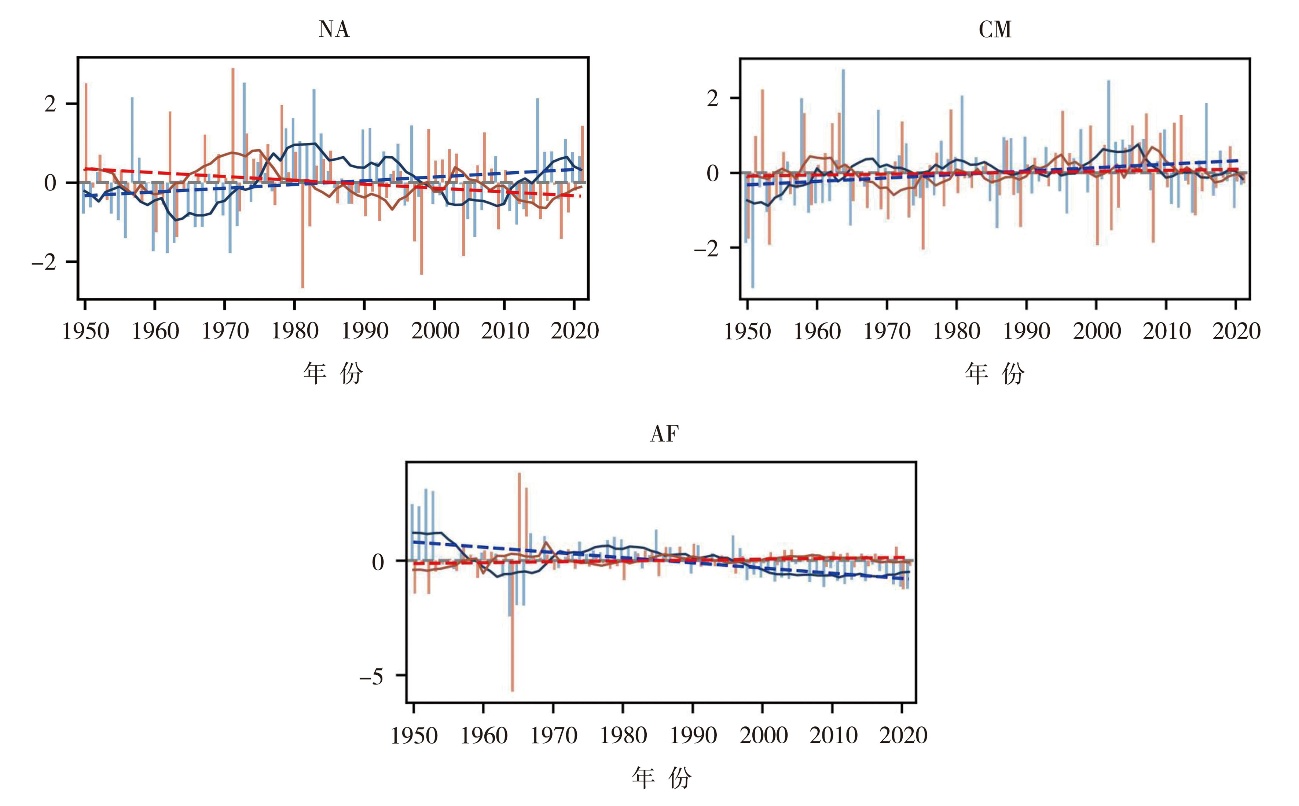
图7 1950—2020年3个陆气耦合关键区内春夏之间陆气耦合强度与夏季降水的年际变化
Fig.7 Interannual variation of spring-summer land-atmosphere coupling intensity and summer precipitation in three land-atmosphere coupling key areas from 1950 to 2020
| 时段 | NA | MS | CM | AF | SA |
|---|---|---|---|---|---|
| 春季 | -0.350** | -0.469** | -0.211* | -0.164 | -0.335** |
| 夏季 | -0.580** | 0.071 | -0.301** | -0.821** | -0.217* |
| 春夏之间 | -0.156 | 0.044 | -0.167 |
表1 北半球陆气耦合强度和降水的相关系数
Tab.1 Correlation coefficients between the land-atmosphere coupling intensity and precipitation in the Northern Hemisphere
| 时段 | NA | MS | CM | AF | SA |
|---|---|---|---|---|---|
| 春季 | -0.350** | -0.469** | -0.211* | -0.164 | -0.335** |
| 夏季 | -0.580** | 0.071 | -0.301** | -0.821** | -0.217* |
| 春夏之间 | -0.156 | 0.044 | -0.167 |
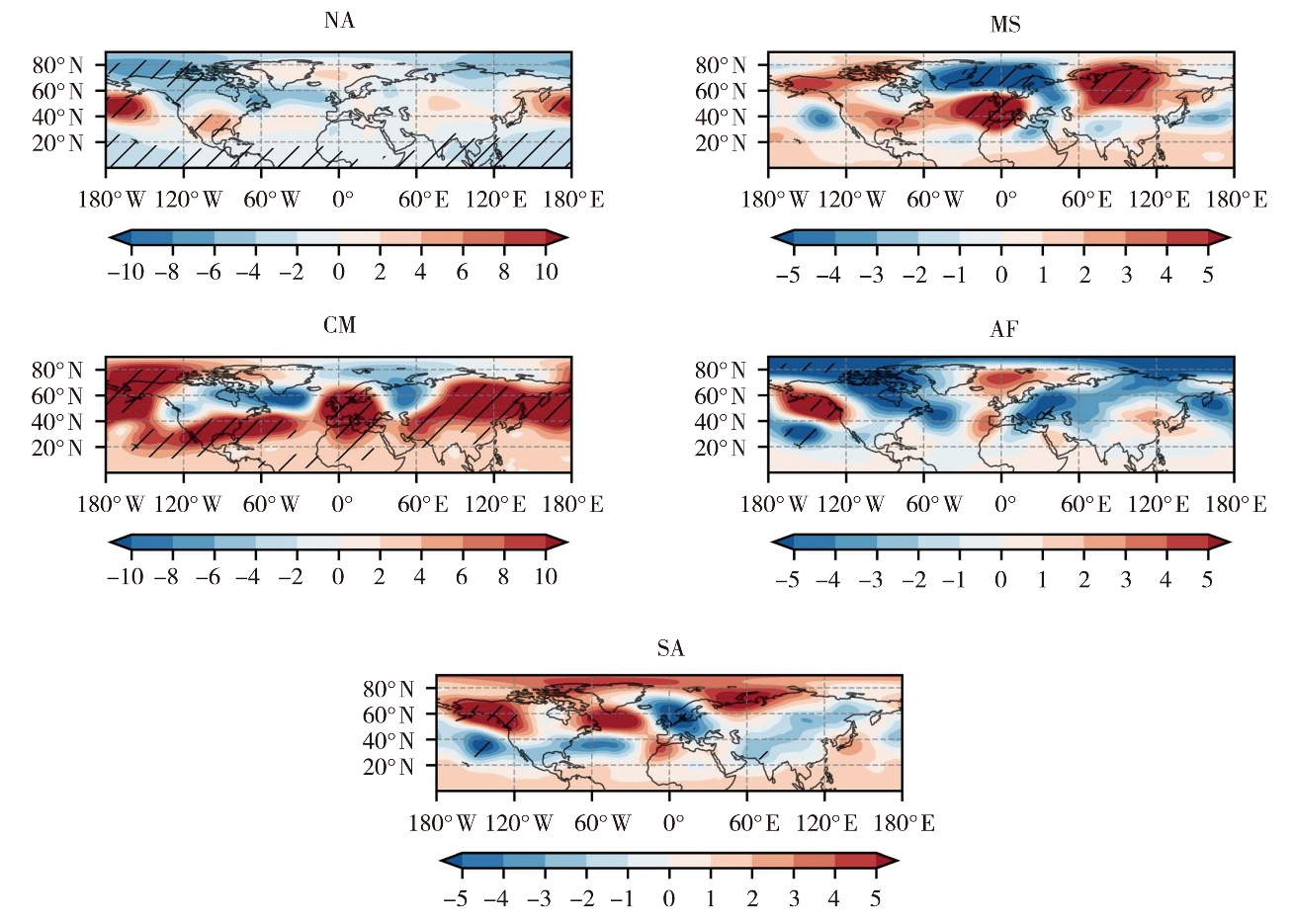
图8 1950—2020年北半球春季陆气耦合强度回归的同期500 hPa位势高度场(单位:gpm) (斜线表示通过0.05的显著性检验,下同)
Fig.8 The 500 hPa geopotential height regressed by the index of land-atmosphere coupling strength over the Northern Hemisphere in spring during 1950-2020 (Unit: gpm) (the diagonal area passing the significance test at 0.05,the same as below)
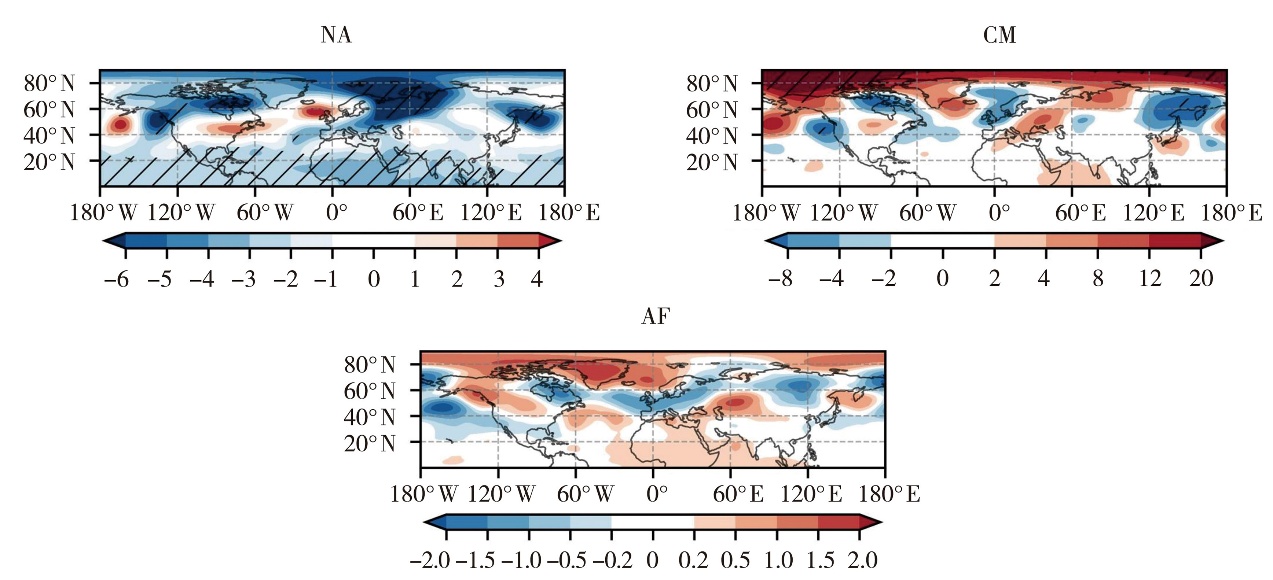
图10 1950—2020年春夏之间陆气耦合强度回归的北半球夏季500 hPa位势高度场(单位:gpm)
Fig.10 The 500 hPa geopotential height regressed by the index of land-atmosphere coupling strength between spring and summer over the Northern Hemisphere during 1950-2020 (Unit: gpm)
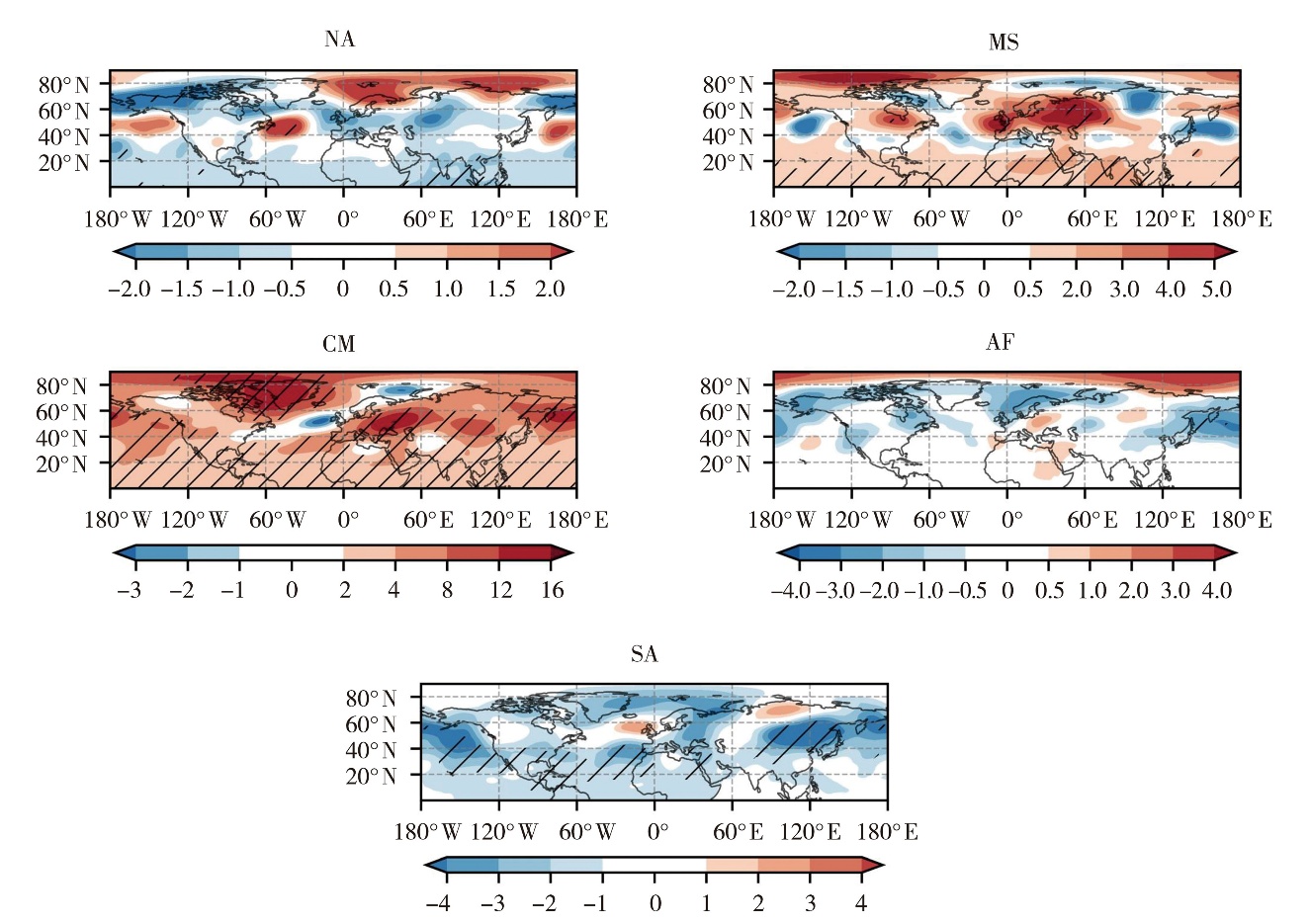
图9 1950—2020年北半球夏季陆气耦合强度回归的同期500 hPa位势高度场(单位:gpm)
Fig.9 The 500 hPa geopotential height regressed by the index of land-atmosphere coupling strength over the Northern Hemisphere in summer during 1950-2020 (Unit: gpm)
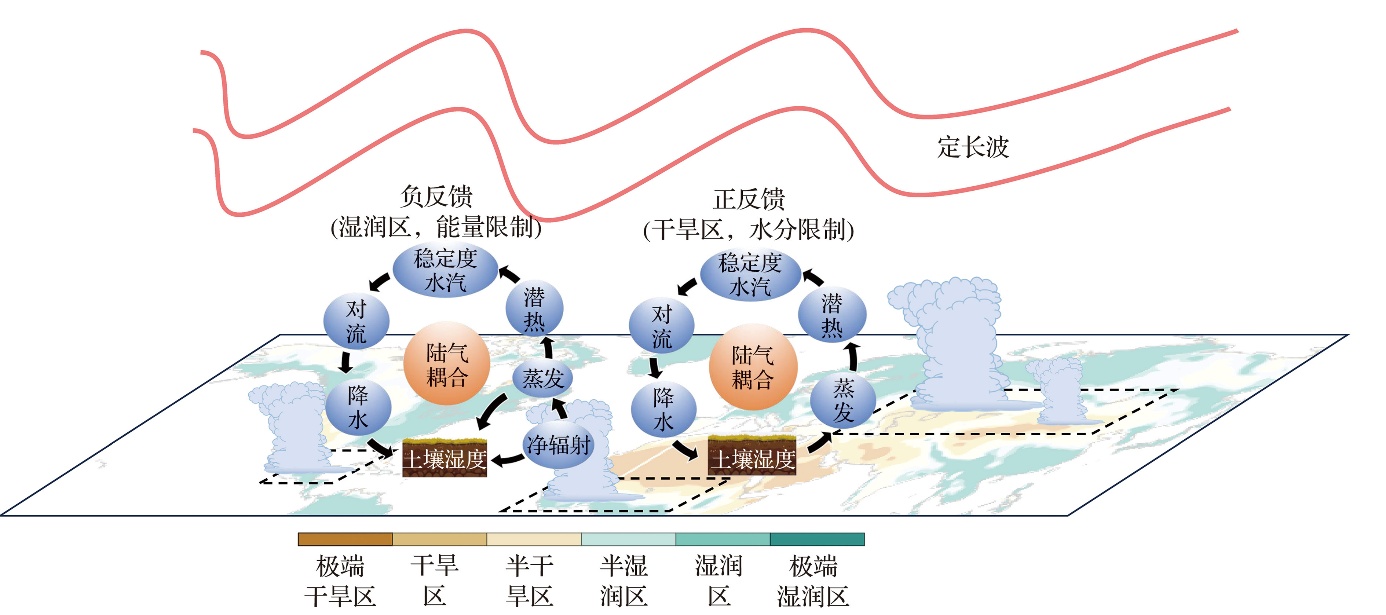
图11 陆气耦合关键区陆气耦合强度与降水关系的概念图
Fig.11 Diagram of the relationship between the land-atmosphere coupling intensity and precipitation in the land-atmosphere coupling key areas
| [1] | 陈泠羽, 陈海山, 齐雅静, 2025. 陆-气耦合对中国东部夏季高温事件影响的区域性差异及其可能机制[J]. 大气科学, 49(1):107-122. |
| [2] | 黄荣辉, 陈际龙, 刘永, 2011. 我国东部夏季降水异常主模态的年代际变化及其与东亚水汽输送的关系[J]. 大气科学, 35(4): 589-606. |
| [3] |
蒋靖海, 王澄海, 2020. 北半球季节性冻融区与北半球夏季降水关系的研究[J]. 冰川冻土, 42(1): 53-61.
DOI |
| [4] |
李登宣, 王澄海, 2016. 青藏高原春季土壤湿度与中国东部夏季降水之间的关系[J]. 冰川冻土, 38(1): 89-99.
DOI |
| [5] | 李课臣, 2022. 北半球陆气相互作用关键区及其与大气环流关系的研究[D]. 兰州: 兰州大学. |
| [6] | 李若麟, 保鸿燕, 李课臣, 等, 2016. 全球土壤湿度的记忆性及其气候效应[J]. 冰川冻土, 38(6): 1 470-1 481. |
| [7] | 李忠贤, 陈海山, 倪东鸿, 等, 2012. 土壤湿度对东亚夏季气候潜在可预报性影响的数值模拟[J]. 大气科学学报, 35(4): 423-430. |
| [8] | 林朝晖, 杨晓松, 郭裕福, 2001. 陆面过程模式对土壤含水量初值的敏感性研究[J]. 气候与环境研究, 6(2): 240-248. |
| [9] | 马柱国, 魏和林, 符淙斌, 2000. 中国东部区域土壤湿度的变化及其与气候变率的关系[J]. 气象学报, 58(3): 278-287. |
| [10] | 史一丛, 陈海山, 高楚杰, 2015. 土壤湿度初始异常对东亚区域气候模拟影响的敏感性试验[J]. 气象科学, 35(4): 379-388. |
| [11] | 孙丞虎, 李维京, 张祖强, 等, 2005. 淮河流域土壤湿度异常的时空分布特征及其与气候异常关系的初步研究[J]. 应用气象学报, 16(2): 129-138. |
| [12] | 孙莉娟, 陈海山, 潘敖大, 等, 2015. 土壤湿度年际异常对中国春、夏季气候模拟的影响[J]. 气象科学, 35(5): 521-533. |
| [13] | 佟华, 刘辉志, 陈起英, 等, 2007. 土壤湿度初值对边界层物理量预报影响的分析[J]. 气候与环境研究, 12(4): 546-552. |
| [14] | 王澄海, 尚大成, 2007. 藏北高原土壤温、湿度变化在高原干湿季转换中的作用[J]. 高原气象, 26(4): 677-685. |
| [15] | 杨扬, 杨启东, 王芝兰, 等, 2021. 中国区域陆气耦合强度的时空分布特征[J]. 干旱气象, 2021, 39(3): 374-385. |
| [16] | 张强, 岳平, 张良, 等, 2019. 夏季风过渡区的陆-气相互作用:述评与展望[J]. 气象学报, 77(4):758-773. |
| [17] | 张文君, 周天军, 智海, 2012. 土壤湿度影响中国夏季气候的数值试验[J]. 气象学报, 70(1): 78-90. |
| [18] | 曾毓金, 谢正辉, 2015. 基于CMIP5模拟的中国区域陆气耦合强度评估及未来情景预估[J]. 气候与环境研究, 20(3):337-346. |
| [19] | ALFIERI L, CLAPS P, D’ODORICO P, et al, 2008. An analysis of the soil moisture feedback on convective and stratiform precipitation[J]. Journal of Hydrometeorology, 9(2): 280-291. |
| [20] | CHEN H S, 2022. Key regions where land surface processes shape the East Asian climate[J]. Atmospheric and Oceanic Science Letters, 15(3): 100209. DOI: 10.1016/j.aosl.2022.100209. |
| [21] | CHOW K C, CHAN J C L, SHI X L, et al, 2008. Time-lagged effects of spring Tibetan Plateau soil moisture on the monsoon over China in early summer[J]. International Journal of Climatology, 28(1): 55-67. |
| [22] | DIRMEYER P A, 2006. The hydrologic feedback pathway for land-climate coupling[J]. Journal of Hydrometeorology, 7(5): 857-867. |
| [23] | DIRMEYER P A, 2011. The terrestrial segment of soil moisture-climate coupling[J]. Geophysical Research Letters, 38(16): 136. DOI: 10.1029/2011GL048268. |
| [24] | GAO C J, CHEN H S, SUN S L, et al, 2018. Regional features and seasonality of land-atmosphere coupling over Eastern China[J]. Advances in Atmospheric Sciences, 35(6): 689-701. |
| [25] | GUO Z C, DIRMEYER P A, KOSTER R D, et al, 2006. GLACE: The global land-atmosphere coupling experiment. Part II: Analysis[J]. Journal of Hydrometeorology, 7(4): 611-625. |
| [26] | KOSTER R D, SUÁREZ M J, 1995. Relative contributions of land and ocean processes to precipitation variability[J]. Journal of Geophysical Research:Atmospheres, 100(D7): 13 775-13 790. |
| [27] | KOSTER R D, CHANG Y H, SCHUBERT S D, 2014. A mechanism for land-atmosphere feedback involving planetary wave structures[J]. Journal of Climate, 27(24): 9 290-9 301. |
| [28] | KOSTER R D, CHANG Y H, WANG H L, et al, 2016. Impacts of local soil moisture anomalies on the atmospheric circulation and on remote surface meteorological fields during boreal summer: A comprehensive analysis over North America[J]. Journal of Climate, 29(20): 7 345-7 364. |
| [29] | KOSTER R D, DIRMEYER P A, GUO Z C, et al, 2004. Regions of strong coupling between soil moisture and precipitation[J]. Science, 305(5687): 1 138-1 140. |
| [30] | KOSTER R D, SUÁREZ M J, HEISER M, 2000. Variance and predictability of precipitation at seasonal-to-interannual timescales[J]. Journal of Hydrometeorology, 1(1): 26-46. |
| [31] | LI K C, ZHANG F M, YANG K, et al, 2022. Improvement of summer precipitation simulation by correcting biases of spring soil moisture in the seasonal frozen-thawing zone over the Northern Hemisphere[J]. Climate Dynamics, 58(9): 2 767-2 780. |
| [32] | MENG L, LONG D, QUIRING S M, et al, 2014. Statistical analysis of the relationship between spring soil moisture and summer precipitation in East China[J]. International Journal of Climatology, 34(5): 1 511-1 523. |
| [33] | MUÑOZ SABATER J, 2019. ERA5-Land hourly data from 1950 to present[J]. Copernicus Climate Change Service Climate Data Store. DOI:10.24381/cds.e2161bac. |
| [34] | PITMAN A J, 2003. The evolution of, and revolution in, land surface schemes designed for climate models[J]. International Journal of Climatology, 23(5): 479-510. |
| [35] | PLEIM J E, XIU A J, 2003. Development of a land surface model. Part II: Data assimilation[J]. Journal of Applied Meteorology, 42(12): 1 811-1 822. |
| [36] | RODELL M, HOUSER P R, JAMBOR U, et al, 2004. The global land data assimilation system[J]. Bulletin of the American Meteorological Society, 85(3): 381-394. |
| [37] | SANTANELLO J A Jr, PETERS-LIDARD C D, KUMAR S V, et al, 2009. A modeling and observational framework for diagnosing local land-atmosphere coupling on diurnal time scales[J]. Journal of Hydrometeorology, 10(3): 577-599. |
| [38] | SCHULZWEIDA U, 2023. CDO user guide (2.3.0)[M]. Zenodo. DOI: 10.5281/zenodo.10020800. |
| [39] | SENEVIRATNE S I, CORTI T, DAVIN E L, et al, 2010. Investigating soil moisture-climate interactions in a changing climate: A review[J]. Earth-Science Reviews, 99(3/4): 125-161. |
| [40] | WANG C H, CUI Z Q, 2018. Improvement of short-term climate prediction with indirect soil variables assimilation in China[J]. Journal of Climate, 31(4): 1 399-1 412. |
| [41] | WEI J F, DIRMEYER P A, 2012. Dissecting soil moisture-precipitation coupling[J]. Geophysical Research Letters, 39(19): 2012GL053038. DOI: 10.1029/2012gl053038. |
| [42] | YANG K, WANG C H, 2019. Seasonal persistence of soil moisture anomalies related to freeze-thaw over the Tibetan Plateau and prediction signal of summer precipitation in eastern China[J]. Climate Dynamics, 53(3): 2 411-2 424. |
| [43] | YANG K, WANG C H, BAO H Y, 2016. Contribution of soil moisture variability to summer precipitation in the Northern Hemisphere[J]. Journal of Geophysical Research: Atmospheres, 121(20): 12 108-12 124. |
| [44] | YANG Z S, ZHANG Q, ZHANG Y, et al, 2025. Water-heat synergy shapes evapotranspiration-precipitation coupling patterns across northern China[J]. Advances in Atmospheric Sciences, 42(6): 1 167-1 178. |
| [45] | ZHANG J Y, WANG W C, LEUNG L R, 2008. Contribution of land-atmosphere coupling to summer climate variability over the contiguous United States[J]. Journal of Geophysical Research: Atmospheres, 113(D22). DOI:10.1029/2008JD010136. |
| [46] | ZHANG J, WU L, DONG W, 2011. Land-atmosphere coupling and summer climate variability over East Asia[J]. Journal of Geophysical Research: Atmospheres, 116: D05117. DOI:10.1029/2010JD014714. |
| [47] | ZHANG Y K, WAGNER N, GOERGEN K, et al, 2024. Summer evapotranspiration-cloud feedbacks in land-atmosphere interactions over Europe[J]. Climate Dynamics, 62(12): 10 767-10 783. |
| [48] | ZOMER R J, XU J C, TRABUCCO A, 2022. Version 3 of the global aridity index and potential evapotranspiration database[J]. Scientific Data, 9(1). DOI: 10.1038/s41597-022-01493-1. |
| [49] | ZUO Z Y, ZHANG R H, 2007. The spring soil moisture and the summer rainfall in Eastern China[J]. Chinese Science Bulletin, 52(23): 3 310-3 312. |
| [1] | 陈敏, 陈豫英, 陈荣, 陈宇曦, 杨苑媛. 贺兰山东麓暴雨天气分型及气象要素演变特征研究[J]. 干旱气象, 2025, 43(3): 413-423. |
| [2] | 靳振华, 卜清军, 黄安宁. 冷涡背景下天津夏季三次不同强度极端短时强降水物理量特征对比分析[J]. 干旱气象, 2025, 43(3): 424-434. |
| [3] | 程瑶, 赵腾, 杨苑媛. ROSE2.1短时强降水自动报警产品在宁夏北部的适用性评估[J]. 干旱气象, 2025, 43(3): 469-478. |
| [4] | 苏天鑫, 孟宪红, 杨显玉, 安颖颖, 赵采玲. 1963—2022年西北地区中西部干旱演变特征及植被响应研究[J]. 干旱气象, 2025, 43(2): 163-175. |
| [5] | 何杭, 杨泽粟, 邬钰嫣. 气候过渡区不同生态系统多陆面因子-大气耦合特征[J]. 干旱气象, 2025, 43(2): 207-220. |
| [6] | 曲巧娜, 吴炜. 太行山及以东复杂地形下多模式降水预报日变化偏差特征研究[J]. 干旱气象, 2025, 43(2): 308-320. |
| [7] | 潘永地, 肖晶晶, 潘彦华, 石界. 一种基于累积降水与累积蒸发的气象干旱指数[J]. 干旱气象, 2025, 43(1): 1-10. |
| [8] | 刘嘉慧敏, 李明, 欧阳雨, 吉庆, 王青霞, 李文耀, 李涵钰. 秦岭北麓盛夏典型突发性降水过程中低层风特征[J]. 干旱气象, 2025, 43(1): 41-53. |
| [9] | 张治国, 崔炜, 聂凯, 李林. 基于精细化观测的国家体育场区域气温特征研究[J]. 干旱气象, 2025, 43(1): 88-96. |
| [10] | 李桉孛, 张萌, 李如琦, 牟欢, 万瑜. 基于K-means聚类的新疆暖季降水日变化特征[J]. 干旱气象, 2025, 43(1): 104-113. |
| [11] | 万羽, 许冠宇, 钟敏, 刘瑞雪, 刘文婷. 基于多模式融合的湖北逐时短时强降水预报方法改进[J]. 干旱气象, 2025, 43(1): 143-152. |
| [12] | 任至涵, 倪长健, 石荞语, 陈宁. 基于最优概率分布函数的成都市近63 a干旱特征分析[J]. 干旱气象, 2024, 42(6): 844-853. |
| [13] | 张雯, 王岱, 马阳, 崔洋, 蒯亦雄, 黄莹. 不同气候态时段宁夏气温、降水变化对比分析[J]. 干旱气象, 2024, 42(6): 889-899. |
| [14] | 韩晶, 焦美玲, 曹彦超, 王娟, 贺涛, 徐耕, 周忠文, 金满慧. 基于CRA空间检验技术的甘肃河东汛期降水智能网格预报偏差特征分析[J]. 干旱气象, 2024, 42(6): 976-986. |
| [15] | 郑丽君, 肖安, 李浙华. 江西大气整层可降水量特征及其与暴雨的关系[J]. 干旱气象, 2024, 42(5): 755-766. |
| 阅读次数 | ||||||
|
全文 |
|
|||||
|
摘要 |
|
|||||
